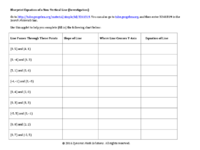
Blueprint Equation of a Line (I)
Blueprint Equation of a Nonvertical Line (Investigation)
Rotations
|
Use the slider to rotate the kite about point C. Point C and the kite can be moved independently. Check the 'Show Distance' box to measure the distance of one of the vertices of the kite and it's image to the center of rotation. Check the 'Show Angle of Rotation' box to show the angle of rotation from a point on the kite to its corresponding point on the image. |
|
|
|
1. Under the rotation, are there any points that do not move? 2. What do you observe the relationship segments formed by corresponding points and the center? 3. Predict what the coordinates of the vertices of the image will be if you rotate the kite 90 degrees counterclockwise. 4. Move the slider to 90 degrees. Compare the coordinates of point A and point A'. 5. What would be the coordinates of point (x,y) if it was rotated 90 degrees counterclockwise about the origin? 6. Does that rule hold true if the center of rotation is not the origin? 7. Repeat questions 3-6 for 180 degrees and 270 degrees. |
Triangle with sides and angles measured
Pythagoras's Theorem
Constructing Triangles Using Side Lengths
Area Relations
|
[color=#c51414]red represents the square and it's relations.[/color] [color=#1551b5]Blue represents the right triangle and it's relations.[/color] [color=#0a971e]green represents the circle and it's relations.[/color] |
|
|
|
[b]adjust the slider[/b] to answer the questions based on observation: 1.) Does one figure always have a larger area than the other figures? If so which one? 2.) Is the growth of any of these figures linear? if so which one? 3.) Can you estimate any proportions when comparing the proportions of any of the figures? (e.g. one area may always be 1/5 the area of another figure) |
